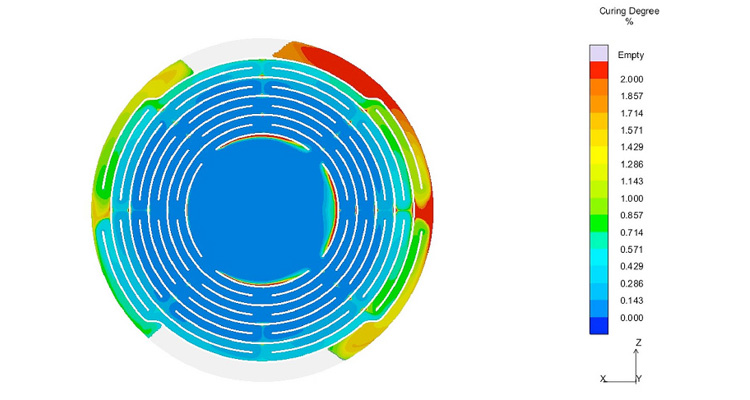Mastering the Challenges in LSR Molding Together with the partners Momentive and CVA Silicone, SIGMA shows at Fakuma 2015 how processors can prepare themselves to face the challenges in LSR processing. Besides the choice of the right material, the process window definition has a major role, to avoid problems in production. Additionally, SIGMASOFT® Virtual Molding supports the molder with its improved material database, which includes from v5.1 a number of LSR materials from Momentive.Figure 1 – Carry mesh “Ursula” (right, CVA Silicone) and temperature distribution in the mold during production (left, SIGMA).
Mastering the Challenges in LSR Molding Aachen, October 12th 2015 – Products made of LSR (Liquid Silicon Rubber) confront the molder with special challenges. Due to its rheological properties and curing kinetics, the desired quality outcome can only be achieved through a narrow process window. However, LSR has good physiological properties and a high thermal stability and has therefore a growing demand, particularly in the medical, baby care and design sectors.To face the challenging production with sufficient preparation, the narrow processing window can be set up upfront with SIGMASOFT® Virtual Molding. This way the processor increases his know-how for future projects, and also the process stability. The risks associated with costs and delivery dates are also reduced.The advantages of a virtual injection molding process are shown by SIGMA Engineering GmbH at Fakuma 2015 in a joint project with Momentive Performance Materials Inc. and CVA Sillicone. For this purpose, the design article “Ursula”, a carry-mesh for bottles, is evaluated with SIGMASOFT® Virtual Molding. The interlaced geometry of “Ursula” with a maximum flow-length of 619 mm requires stable flow and curing properties, to guarantee a robust process and the required part quality.To reach this goal, the manufacturing feasibility was evaluated with SIGMASOFT® Virtual Molding. Not only the part, but the complete mold was taken into account, including cold runner, over several molding cycles. Besides the filling of the mold (Figure 2) and the part curing behavior, also the complete thermal mold behavior was considered (Figure 1). The thermal response of the mold has a decisive impact on the part properties. The comprehensive rheological and thermal analysis shows that the Silopren LSR 2670 meets the production requirements of Ursula. The results of the virtual production are shown at Fakuma at the SIGMA Booth, A5-5105. A Live-Demo is presented at the booth of Momentive (A4-4307), where Ursula will be produced in a CVA mold.To achieve an accurate prediction with SIGMASOFT®, besides the complete mold and process data, it is important to have precise material data, to calculate exactly the material behavior. To make those easier accessible for SIGMASOFT® users, Momentive delivers the material data of a large number of its materials to SIGMA. The new material data for several standard and special LSR grades are available for the user in the SIGMASOFT® v5.1 database.xte
